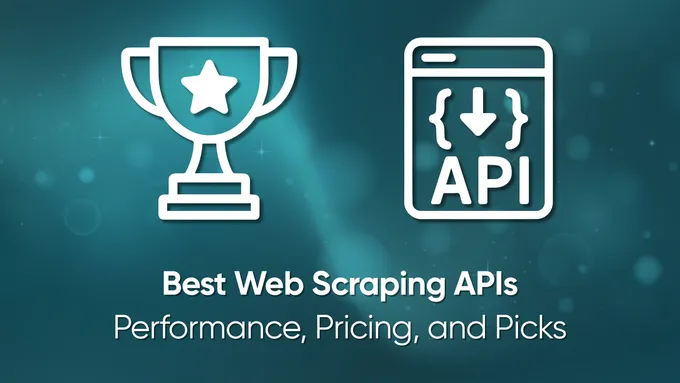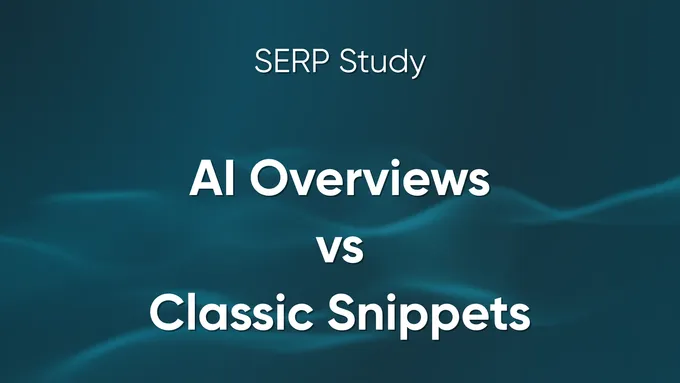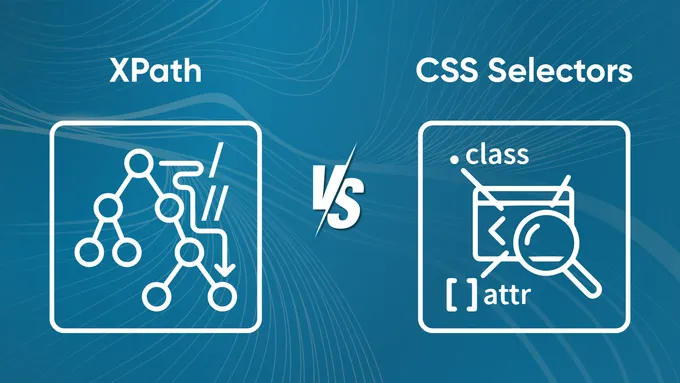What Is Web Scraping and How You Can Use It in 2026
Web scraping is the automated process of collecting public data from the internet using software. It works by simulating a human browsing a website to fetch specific information and exporting it into a structured format like a spreadsheet, database, or API.
Most online data is trapped in unstructured formats. Websites are designed for human eyes rather than computer algorithms. This visual focus makes it difficult to analyze information at scale. Manual copy-pasting is slow, expensive, and prone to errors. Web scraping solves this problem by converting the messy web into clean and usable datasets.
This technology has moved beyond simple automation. As we enter 2026, web scraping has become critical business infrastructure. It fuels training data for AI models, powers real-time pricing for e-commerce, and delivers market signals to financial institutions. It is now the standard way to turn the web into actionable insights.
How Web Scraping Actually Works
At its core, web scraping is the process of reverse-engineering a web browser’s behavior. A browser (like Chrome) takes code and turns it into pixels for your eyes. A scraper takes code and turns it into data for your database.
It transforms the “Human Web” (messy, visual) into the “Machine Web” (structured, logical). Here is the lifecycle of that transformation.
While every tool is different, the core mechanics always follow this four-step lifecycle.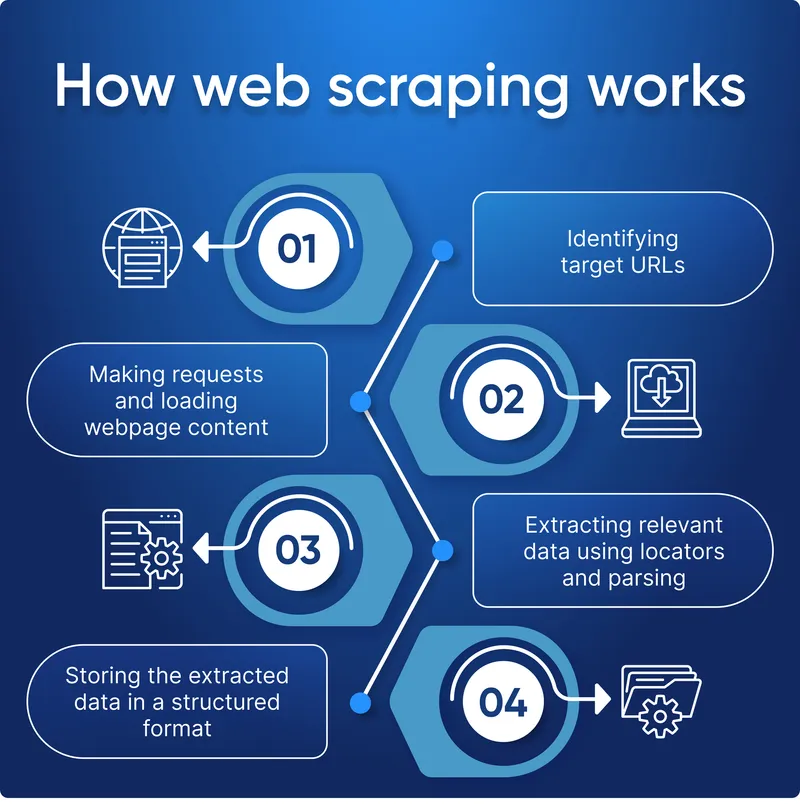
1. The Request
This is not just “asking” for a page. In 2026, most servers are hostile to bots and your raw HTTP request gets blocked immediately.
The scraper must construct a request that is indistinguishable from a human user. This goes beyond simple headers like User-Agent. Modern anti-bot systems analyze the TLS Fingerprint (often referred to as JA3 signatures).
When a browser connects to a server, it sends a specific sequence of cryptographic algorithms (ciphers) in the initial ClientHello packet. A standard Python script sends a completely different sequence than a Chrome browser.
If this cryptographic handshake doesn’t match a real browser’s signature, the server rejects the connection instantly, before you even request the data.
2. The Response
The server accepts the handshake and sends back the content.
But unlike what you see on your monitor, the scraper receives the Raw HTML - a massive block of text tags, links, and scripts. This is the “Matrix code” behind the visual interface. It contains the data you want (prices, titles), buried inside thousands of lines of layout instructions, ad scripts, and tracking pixels.
3. Parsing
Once the content is loaded, the scraper parses the Document Object Model (DOM). Instead of “reading” the page like a human, it uses specific Selectors (XPath or CSS) to find exact coordinates in the code.
It doesn’t look for a visual label like “Price: $10”. Instead, it hunts for a specific code path, such as div.product-price > span.value. This allows it to ignore the noise (ads, navigation bars, footers) and extract only the exact value required with pinpoint accuracy.
4. Storage
Finally, the data is isolated from the HTML and serialized.
The scraper takes the raw, messy strings extracted from the HTML and cleans them into structured formats. It strips away whitespace, converts currency strings into floating-point numbers, and formats dates. This process transforms the chaotic web content into a clean CSV file for analysis or a queryable SQL database ready for business intelligence tools.
Major Benefits of Web Scraping
The web scraping market hit USD 1.03 billion in 2025 and is projected to double to $2 billion by 2030 (14.2% CAGR). This growth crushes the human bottleneck in data acquisition. It swaps linear manual labor for parallelized, always-on extraction pipelines that deliver velocity, volume, and structure that humans simply cannot match.
Here are the five structural advantages of automated extraction:
1. Unmatched Speed and Concurrency
Manual data collection is linear. One human can process perhaps 50 records per hour. Web scraping is exponential. A well-optimized script using parallel requests can process thousands of pages in seconds.
- Cost Efficiency: You replace hundreds of billable human hours with a few dollars of server time.
- Availability: Scrapers run 24/7/365 without fatigue, holidays.
Whether you need to extract data from 100 pages or 100 million pages, the process is identical. The only variable is the infrastructure, not the headcount.
2. Structured Precision
Human data entry has an inherent error rate (typos, missed fields, fatigue). A web scraper has zero logic variance.
- The Logic: If you tell a scraper to extract the text inside span.price, it will extract exactly that, every single time.
- The Output: You don’t get messy notes, you get validated, clean data. Price as a float, a date as a timestamp, and a SKU as a string.
This reliability is critical for downstream analytics and database integrity.
3. Real-Time Market Intelligence
In industries like finance or e-commerce, data from yesterday is useless.
- The Capability: Scrapers can monitor targets continuously - running every hour, minute, or even second.
- The Application: This allows businesses to react instantly. If a competitor drops a price or a stock ticker moves, your system triggers an alert immediately, rather than waiting for a weekly manual report.
This shifts your business from “reactive” (analyzing history) to “proactive” (acting on live data).
4. Infinite Scalability
Scaling manual data collection requires hiring more people (linear cost growth). Scaling a web scraper requires upgrading a server instance (marginal cost growth).
- The Math: Accessing vast amounts of market data becomes a fixed infrastructure cost rather than a variable labor cost.
- The Shift: It allows your team to stop being “data collectors” and start being “data analysts,” focusing on high-value strategy instead of rote tasks.
5. Accessing Data Where No API Exists
This is the most critical technical benefit. While platforms like YouTube or Salesforce offer official APIs, 99% of the web does not.
- The Problem: Most valuable data (competitor pricing, real estate listings, legacy government records) is locked behind visual HTML interfaces without a public API.
- The Solution: Scraping treats the website itself as an API. It allows you to build applications on top of data sources that were never intended to be accessible programmatically.
Web Crawler vs. Web Scraper: The Architectural Distinction
While often used interchangeably, these terms refer to distinct components in a data pipeline. Think of it as the difference between a Surveyor and a Miner.
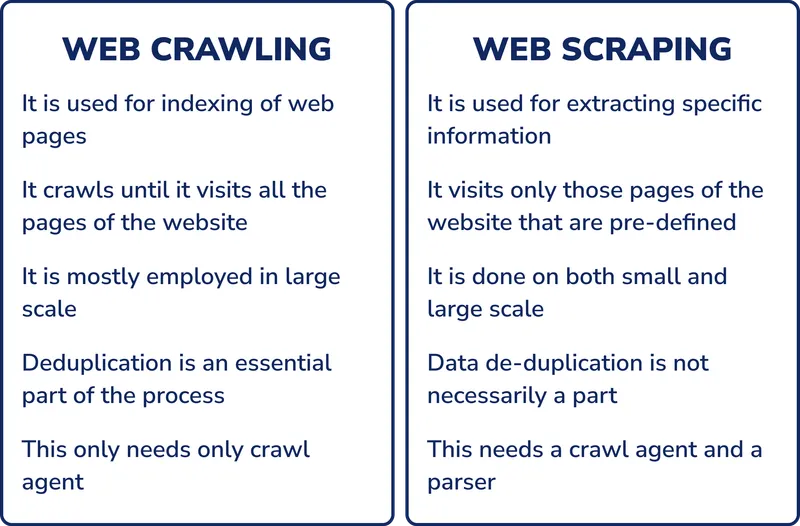
The Web Crawler
- Goal: Discovery.
- Function: A crawler browses the web broadly to map what exists. It downloads a page, parses it to extract URLs, and adds them to a queue. It is generally agnostic to the content payload.
- Example: Googlebot. It crawls billions of pages to build a search index, not to extract structured datasets.
The Web Scraper
- Goal: Extraction.
- Function: A scraper visits specific targets to extract precise data points. It ignores unrelated navigation and focuses entirely on the DOM logic (e.g., targeting
div.price). - Example: Price Intelligence Scripts. A script that visits 50 specific Amazon product pages every hour to record price fluctuations.
The Hybrid Reality
In enterprise data acquisition, these components usually work in tandem. A Crawler scans a category page to discover new product URLs, and hands them off to a Scraper to extract the detailed specifications from each product page.
For a detailed breakdown of the architectural differences and when to use which, read our full guide: Web Scraping vs Web Crawling: What’s the Difference?
Top Use Cases for Web Scraping
Raw data is useless until it solves a specific business problem. In 2026, companies do not just “collect” data. They scrape to feed automated pipelines that drive revenue, train models, and optimize operations.
Here are the six primary applications where automated extraction replaces manual effort.
1. Market Research & E-commerce
Retailers and brands use web scraping to convert competitor pricing from a manual check into a programmatic signal. This allows systems to react instantly to market fluctuations rather than waiting for weekly reports. A scraper can monitor thousands of SKUs across multiple marketplaces to detect stock changes or price drops the moment they happen.
- Dynamic Pricing: Algorithms adjust your product prices automatically based on competitor moves to protect margins or win the Buy Box.
- MAP Monitoring: Brands track thousands of third-party sellers to ensure they are complying with Minimum Advertised Price policies.
- Inventory Intelligence: Systems detect when a competitor goes out of stock to immediately increase ad spend on similar products.
To implement these strategies, engineering teams often use specialized tools like our Amazon Products API or Shopify Scraper. You can also build your own custom solutions using our guides on Scraping Amazon Product Data and Scraping Walmart.
2. Lead Generation & Data Enrichment
Effective sales operations use scraping for data enrichment rather than blind outreach. Teams start with a basic prospect list and programmatically fetch missing context like verified emails, technology stacks, or decision-maker roles from public directories.
This approach focuses on precision rather than volume.
- B2B Prospecting: Scrapers aggregate decision-maker profiles from professional networks and verify their current roles.
- Contact Verification: Systems cross-reference company domains with public directories to validate emails and phone numbers.
- Local Lead Gen: Agencies extract business details from map services to find local companies that need specific services.
This strategy delivers tangible results. For example, a Data-as-a-Service company used our Google SERP API to enrich their datasets, achieving 4x higher coverage of verified emails compared to traditional providers like Hunter or Clearbit.
To build your own pipeline, check out how to scrape LinkedIn with Python and our guide on how to extract emails from Google Maps.
3. Real Estate Analytics
Investors and agencies use automated extraction to aggregate fragmented listings from hundreds of agent websites into a single master database. This centralization allows for instant analysis of rental yields, neighborhood trends, and asset valuation.
- Yield Estimation: Investors combine purchase price data from Zillow with rental rate data from Airbnb to calculate potential cap rates for specific neighborhoods.
- Status Tracking: Lenders monitor thousands of properties daily to detect status changes or foreclosures immediately.
- Market Forecasting: Analysts track historical pricing trends to predict future valuation shifts.
One real estate lender used our Zillow Data API to automate daily property status checks. This reduced their manual compliance workload by 90% and allowed them to detect listing changes days earlier than before.
For technical implementation, read our tutorials on scraping Zillow data, scraping Redfin properties, and Airbnb data extraction.
4. SEO Monitoring & Rank Tracking
Agencies and SaaS platforms scrape Google SERPs (Search Engine Results Pages) to track thousands of keywords daily across different geolocations and device types.
- Rank Tracking: Agencies monitor the exact position of client keywords daily across mobile and desktop indices.
- Feature Analysis: Scrapers detect the presence of AI Overviews, Local Packs, or Featured Snippets that steal organic traffic.
- Content Gap Analysis: Marketers scrape top-ranking competitor pages to analyze word counts, keyword density, and heading structures.
A 700-person SEO agency recently consolidated their tracking with our SERP API, which allowed them to cancel dozens of redundant software subscriptions and unify reporting for every team.
Learn how to build your own tracker with our guides on scraping Google search results, tracking SERP history, and scraping Google Trends.
5. AI Model Training & RAG
Large Language Models (LLMs) require a constant stream of fresh data to remain accurate. Web scraping provides the Retrieval-Augmented Generation (RAG) layer that connects AI to the real world. By scraping news and technical documentation in real-time, developers prevent models from hallucinating or relying on outdated training sets.
- RAG Pipelines: Fetching live data to answer user queries with up-to-date facts.
- Dataset Creation: Compiling specialized corpora for training niche models.
- Fact Verification: Cross-referencing AI outputs against trusted public sources.
This is the fastest-growing use case in 2025-2026. To feed your own models, read our scraping Google News guide or learn how to Scrape Google Images for computer vision datasets.
Types of Web Scrapers and When to Use Them
Selecting a scraping method is an engineering tradeoff between speed, cost, and evasion capabilities. The modern web uses complex JavaScript rendering and aggressive anti-bot systems (like DataDome or Akamai) that break simple scripts.
Select your approach based on the target website’s complexity and your required scale. Here is the breakdown of the four primary approaches, ranked by engineering complexity and scalability.
1. Browser Extensions
These are plugins that run directly inside your Chrome or Firefox instance. They rely on your own browser to render the page and your own IP address to fetch it.
- Best For: Ad-hoc tasks. Extracting a table from a specific page once a week.
- The Bottleneck: They cannot scale. You cannot run 1,000 concurrent tabs on your laptop without crashing it. Furthermore, because they share your local IP, aggressive scraping will get your office Wi-Fi banned.
- Verdict: Great for prototypes, useless for production pipelines.
2. DIY Scrapers
This is the default for most developers. You build custom logic using libraries like BeautifulSoup (for parsing) and Playwright or Puppeteer (for browser automation).
- Best For: Teams with dedicated engineering resources who need custom extraction logic.
- The Hidden Cost: Building the scraper is 10% of the work. The other 90% is maintenance.
- Dynamic Content: You must manage “Headless Browsers” to render JavaScript, which consumes 10x more RAM/CPU than simple requests. For details, see our guide on How to Scrape Dynamic Content in Python).
- Anti-Bot Evasion: You are responsible for managing TLS Fingerprints (JA3/JA4). Unlike User-Agents which are easily spoofed, modern firewalls analyze the cryptographic handshake of your SSL connection. Standard libraries like requests have a distinct “bot” signature that differs from real browsers, leading to immediate blocks regardless of your IP quality. Our article on avoiding Cloudflare 1020 covers this in depth.
- Proxy Management: You must buy and rotate your own pool of residential proxies to avoid IP bans.
- Verdict: Offers maximum control but requires constant maintenance to keep the pipeline green.
3. No-Code Cloud Scrapers
These are SaaS platforms that provide a visual interface to select data, which is then scraped on the provider’s servers. They occupy a middle ground: offering the infrastructure of an API with the ease of use of a browser extension.
- Best For: Teams that need scheduled, recurring reports (e.g., daily price monitoring) but lack dedicated engineering resources.
- The Trade-off: While powerful, they lack the flexibility of code. Complex logic, such as handling obscure authentication flows or multi-step form submissions can be difficult to implement compared to a custom Python script.
- Verdict: Good for standard use cases, but fails on edge cases.
4. Scraping APIs
When you move from scraping thousands of pages to millions of pages, the challenge shifts from parsing HTML to network engineering. At this scale, websites aggressively block traffic using IP reputation checks and TLS fingerprinting.
A Scraping API abstracts this infrastructure. You send a URL to the API endpoint, and it handles the browser orchestration, proxy rotation, and retries, returning the clean HTML or JSON.
- Best For: Scaling business-critical pipelines without managing infrastructure.
- The Advantage: It solves the “cat and mouse” game for you. When a target site updates its anti-bot protection, the API provider updates their evasion techniques globally. You don’t wake up at 3 AM to fix a broken driver.
- Verdict: The standard for enterprise-grade scraping where reliability outweighs the cost of a few dollars per month.
Read how HasData’s scraper APIs achieve 99.9% uptime at millions of requests.
Is Web Scraping Legal?
The short answer is yes. In the United States and the EU, scraping publicly available data is generally considered legal.
Courts have repeatedly ruled (most notably in hiQ Labs v. LinkedIn and the 2024 Meta v. Bright Data decision) that accessing public information on the open web is not a crime, even if the website’s Terms of Service prohibit it.
However, “legal” does not mean “anything goes.” To keep your operation safe, you must respect three boundaries:
- Personal Data (PII): In the EU (GDPR) and California (CCPA), personal data like names, emails, and phone numbers are protected. Even if this data is public, storing it without a “legitimate interest” is a compliance risk.
- Public vs. Private: Scraping public pages is standard practice. Scraping behind a login screen (authentication) usually requires agreeing to Terms of Service (ToS). Violating these terms is a breach of contract and carries higher legal risk than scraping public pages.
- Copyrighted Content: You can scrape facts (prices, stock tickers, flight times). You cannot scrape and republish creative work (news articles, videos, images) without violating copyright law.
This is a complex topic with varying rules by jurisdiction. Before launching a project, read our full guide “Is Web Scraping Legal? Yes, If You Do It Right”.
Conclusion: Start Small, Scale Smart
Web scraping has evolved from a hacker’s utility into a trillion-dollar data infrastructure. Whether you are building an AI model, monitoring competitor prices, or generating leads, the goal is the same - speed to insight.
You can start small with a browser extension. As you scale, you will face the technical reality of anti-bot systems and dynamic rendering. When that happens, you have a choice: spend engineering hours maintaining proxies and headless browsers, or offload the infrastructure to a dedicated API.
The data is out there. You just need the right tool to get it.
Ready to run your first scrape? You don’t need to build the infrastructure from scratch. Try HasData for free and get your first 1,000 requests on us.

